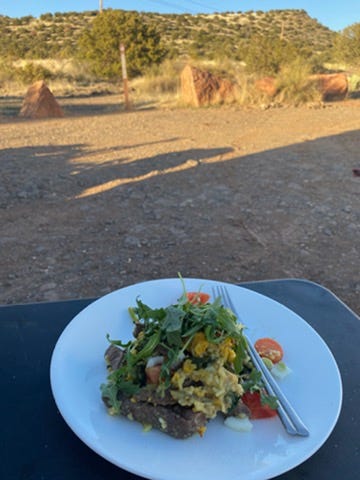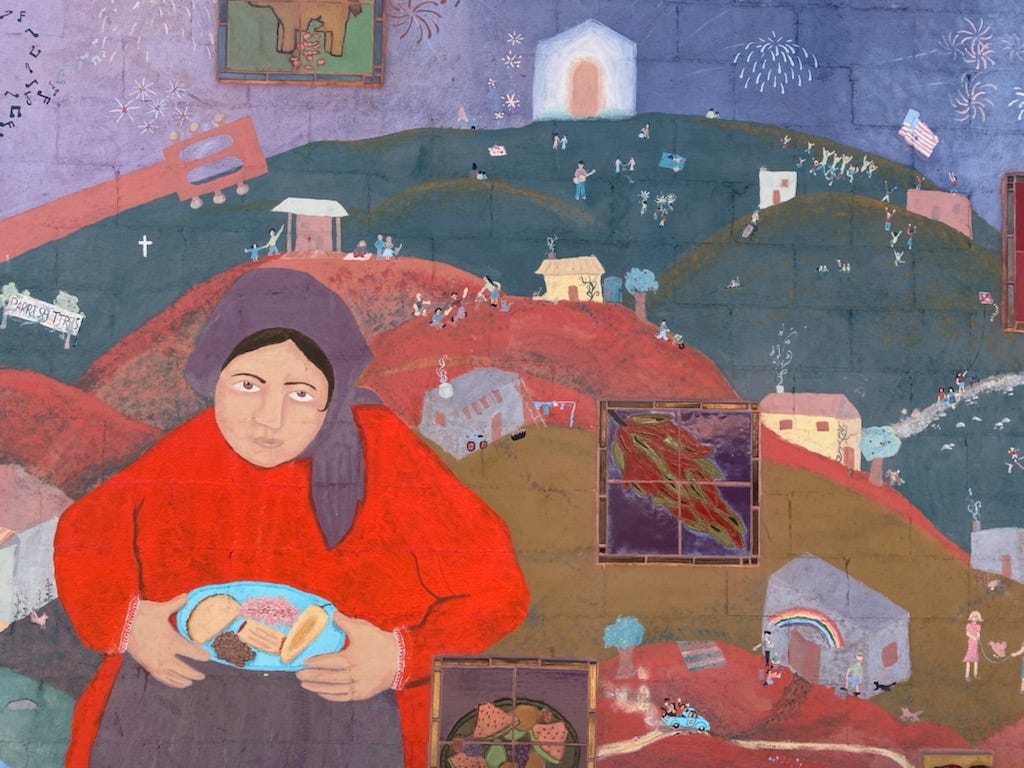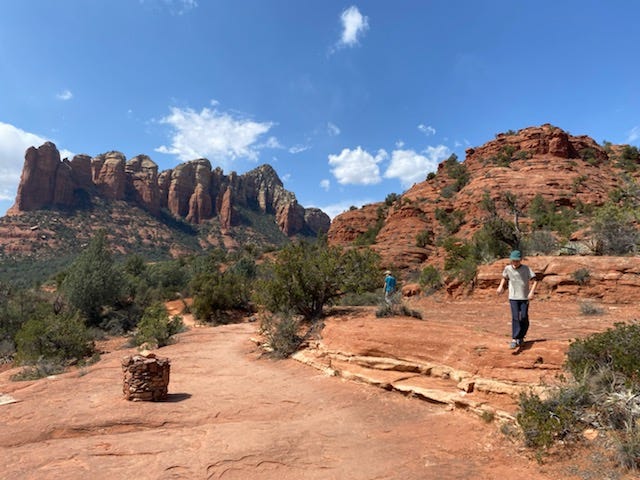When we were in our early twenties, Alex and I lived in Austin. I had started working on an urban farm while Alex managed a restaurant. I was still vegetarian then, and we lived in a vegan co-op, a fourplex apartment building that was painted turquoise and yellow. The co-op had several hippies who also lived there (it was…very Austin). Though we ate a lot of vegetables that we all grew in the co-op’s garden, I didn’t know quite what eating healthy or environmentally-friendly meant; therefore, I made food with a lot of processed, “fake” meats, like soy-based pastrami and tofurky (sorry, Alex! I feel bad about this time in our lives.).

Occasionally, I would ride my bike over to Alex’s restaurant, after hours, late at night, where Alex would let me into the locked doors, as he dealt with paperwork in the back. Waiting for him to be done, I would roam around the restaurant’s kitchen, laced with the ghosts of fried fish and grilled steaks, looking at their Teflon cookware (not good) and shelf-stable ingredients along the metal shelves; big cans of tomato juice (for their tomato-bisque soup topped with gorgonzola cheese, a very popular dish there), canned clams for their pastas, and plastic jugs of yellow “vegetable” oil that seemed to line the room like wallpaper. Though this was a posh Austin restaurant, and I knew it was hardly farm-to-table, it dawned on me then, looking at the rows of endless yellow oil, that this restaurant did not care at all about ingredients. It cared about décor, about aesthetics, and about catering to visiting famous people (Alex had helped serve people like Quentin Tarantino and David Byrne). It definitely didn’t care about supporting small farmers or cooking healthy meals. One night, I looked at the label of the oil: a mixture of cottonseed oil and soy oil, two inflammatory oils that can wreck havoc1 on the gut, brain and the immune system. Likely, it was hydrogenated. Though I didn’t know a ton about healthy ingredients then, I knew at the very least that this oil was a bad one. But this was how this restaurant, and many others, save money; cheap, toxic ingredients, grown for maximum profit, sold in gallons, tubs or vats. (I will note that many restaurants, while not perhaps using the purest ingredients, are small businesses that are just trying to make a profit to support their families. Not the case here, though, where this Austin restaurant was run by someone rich, evidently trying to become more rich.) Looking in this restaurant’s kitchen, a restaurant that was considered “upscale”, made me never want to eat in restaurants again.
Rewinding time before Austin, Alex and I both lived in Chicago, Alex as a bike messenger, and me as receptionist by day, freelance writer by night. When the sun went down in the winter, I would bike home from my receptionist job, gliding through powdery snow in the orange-lit bike lane, getting home to my apartment, starving. I almost never cooked back then, and would order take-out from a noodle shop next door, a white to-go box of salty pan-fried noodles with tofu and red peppers coated in an oily sauce. Lord knows how many of those noodle boxes I ate, how much inflammatory oil I ingested. I do know, though, that I eventually started to feel it in my body; my digestion took a hit, and I realized the food was making me have less energy, not more.
Before the end of the 19th century, people generally got their food from their local farm. After railroads were built, however, food became something not whole and close to the earth anymore, but something packaged, manufactured, and distributed, zooming across tracks around the country. This became a greenlit free-for-all for money-grubbing food manufacturers, eager to rake it in with cheap, adulterated foods, none of which had to be regulated: milk cut with water and chalk paste, and preserved with poisonous formaldehyde, becoming one of the most notable, after many babies and children died after drinking it.
Enter a man named Harvey Wiley, a proponent of the “Pure Food movement” (a pre-cursor to the FDA).2 The Pure Food movement was a movement that was started by women, mostly mothers, who wanted to know what was in these cans, bottles and boxes of grocery store foods, which, at the time, did not have to have a label of ingredients, and also did not have anyone enforcing honesty on their packaging. The Pure Food movement set out to ban harmful food additives, as well as having the food be actually what the label said: milk to be actual milk (instead of chalky water with preservatives) and honey to be actual honey (instead of mostly sugar water and yellow dye). With the public outcry for real food, along with a scandal of canned meat that happened during the Spanish-American war that made many solders sick, Theodore Roosevelt named Wiley as the head of USDA’s Division of Chemistry. Wiley’s main job was to find out what was really in these foods, and what food additives did to the body. What Wiley found was unsurprising, given what was in a bottle of milk; analyzing a jar of black pepper, he found tiny amounts of actual pepper cut with dirt and floor sweepings. Dissecting a bag of coffee, he found one bag of beans that had zero coffee at all; instead, he found pressings of flour, molasses, charred bone for color, burnt chicory root, and some dirt, shaped into little coffee bean molds.
Aside from the pure lies that food manufacturers were selling, the preservatives that were used for canned vegetables and other foods were deadly. In 1901, Wiley put together a group of volunteers—twelve young men—to prove that chemicals in foods were harming the body. The men got fed everyday, plus five dollars a month, but had to suffer through stomachaches caused by their free meals, like boxed mashed potatoes and canned green beans and ham steaks that were laced with borax and other chemical preservatives. No one died, but many men dropped out, due to illness.
It is no surprise that Wiley was public enemy number one for big food business and large manufacturing companies, who wanted to continue their profit with disregard to human health; many people within the government and his own division also wanted to keep Wiley’s findings under wraps, since, like today, the department depended on funds from big corporations. To this, it seems not much has changed within society’s moral fabric in the last one hundred plus years; capitalism still benefits at the expense of human health (see: rows of yellow oil in plastic jugs). However, some things have gotten better: milk has to be milk without additives of chalk mixed with water, ketchup can’t have sodium benzoate as an ingredient anymore, and pepper can’t be laced with floor sweepings. (Many things have not gotten much better, of course, within many companies, like environmental destruction or factory or farm worker abuse, but that is another newsletter.) Though you can go to any grocery store and read a sticker’s ingredient list on a pasta sauce jar, it is still beneficial to make as much as one can from scratch. Growing your own tomatoes and canning them is next-level “know your food” knowledge, along with your pots of herbs in the windowsill and some ethical, health-beneficial sea salt or real salt. Mix it together and you are your own Muir Glen. The Pure Food movement made food better, but reading “soy oil” or “soy protein” or “maltodextrin” on some food labels of certain products show there is a long way to go before many manufacturers make any kind of moralistic change.
What I am urging is for the family cook—whether you are just a family of one, or two, or twenty—to concentrate on filling bodies with health-building, real foods, instead of toxic, disease-building meals. Instead of fast food (the worst, most unethical, profit-driven food there is), we can hopefully steer towards more of cooking with whole, unprocessed ingredients. There is no sorbitol in broccoli, no red dye #5 in butternut squash. That is not to say that I make everything from scratch, and never buy a jar of pasta sauce—I just make sure to read every ingredient, making sure I am not buying one that has sugar or artificial sweeteners that may mess up the gut microbiome, or anything else I don’t recognize as food. Certain ingredients are also on my radar, like the common additive of carrageenan. You can find this ingredient in many dairy and plant-based milks as a thickener, even organic products. Though it is derived from seaweed, it goes through a chemical process that makes it harmful to the body, creating inflammation in many people, encouraging illnesses like colitis and IBS. Companies have refused to remove it, since it is a cheap thickener and stabilizer for foods.3 The FDA, notably, has called it “generally harmless”, and, though there have been independent studies to prove its harmful affects, refuses to study or research the matter further, which, to me, sounds eerily familiar.
Much has improved within the last one hundred years, but much has not. What small thing we can do is cook for ourselves, and cook for our families, and think of food as something that can nourish us, that can make us feel vibrant inside, that can affect our lives for the better. We can cook vegetables in good, healthy fats (think grass-fed, organic butter, pasture-raised lard, ghee, olive oil, coconut oil, or avocado oil) to maximize nutrient absorption. Forget the canola oil or Crisco or any “vegetable” oils. Cook healthy proteins, like beans, lentils, pasture-raised eggs or grass-finished meats. Make your own salad dressings instead of buying the twenty-ingredient bottled stuff; put some olive oil, lemon juice, salt and pepper in a mason jar and shake it if you are new to it. And please, if buying food products, read the ingredients; there are good food companies out there, ones that are ethical, use ingredients without additives, treat and pay their workers well, and support conscientious, ecological food growing. I still go to restaurants occasionally, when it is not cost-prohibitive to do so or when we are in a bind on the road or when we really want to go somewhere special. We will always try to support small restaurants or food trucks when we do this. Some restaurants even do a great job with ingredients. But I mostly cook, since I generally feel much better after eating homecooked meals. Using food as your main, foundational medicine doesn’t have to be anything extraordinary; in reality, it’s all very simple.
In the Tiny Kitchen:
I’m generally inspired by the region I am in (in South Carolina and Georgia, I made a lot of shrimp and grits using local ingredients out there, and would buy huge bags of oysters from shacks on the side of the road, big tarp bags for eighteen dollars, filled with oysters that seemed glued together, not even separated from each other, that I had to have someone help me carry to the car). In Texas and the southwest, however, I am making healthy versions of a lot of my favorite comfort foods: Mexican food and Tex-Mex food, foods like tacos, enchiladas, rice and beans, fajita bowls, and tortilla soups. When we go for hikes, in order to save money and not kill each other from hunger, I usually pack a mason jar of food or a covered glass bowl of something. I am developing and testing an actual recipe for one of my go-tos that everyone in my family loves: a veggie-heavy enchilada casserole. The recipe includes homemade red enchilada sauce, as well as green. Once the enchilada sauces are made (and put in jars to use for future enchiladas), I can make it super fast, then scoop it up and seal it in a to-go bowl to carry with us in a backpack. Mid-hike, this is the best thing ever.
The recipe is made entirely on the stovetop, since we don’t have a working oven in our camper bus. It will be the first recipe for paid subscribers (starting next week!).
On The Road:
This week we are camping in our bus for free, living on just on solar panels, our water we could bring in, and spotty cell reception on public land in Sedona, Arizona. A natural wonderland of massive sandstone rocks made red by iron oxide, speckled with shrubby juniper and pinyon pine trees, it is almost like being on a woodsy Mars. One of Alex and my favorite places to go camping is Big Bend National Park, a magical desert in West Texas. Sedona feels like if Big Bend had a city plopped right in the middle of it. It therefore feels…weird. Like, maybe a city shouldn’t really be here and these majestic red rocks and its surrounding should be left in nature, or be a national park? It feels like this city is run by ladies with tarot cards and crystals, which also feels weird, like a lot of self-indulgence is happening here, but I digress. Anyway, it’s red, it’s beautiful, and we are leaving this week. We are figuring out where our next farm is to work on, but for now, we are slowly inching our way back up north (literally inching, since once again we are having engine problems and need a mechanic to look at this thing).
University of California - Riverside. "America's most widely consumed oil causes genetic changes in the brain: Soybean oil linked to metabolic and neurological changes in mice." ScienceDaily. ScienceDaily, 17 January 2020. <www.sciencedaily.com/releases/2020/01/200117080827.htm>
Blum, Deborah. The Poison Squad: One Chemist's Single-Minded Crusade for Food Safety at the Turn of the Twentieth Century. , 2018. Print
Cornucopia Institute, 2022. https://www.cornucopia.org/carrageenan/






Al and Readers - any fellow fans of Dr Greger? https://nutritionfacts.org/
how do I get the paid recipes! Would love to join.